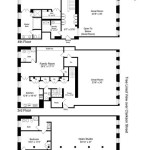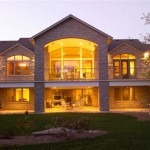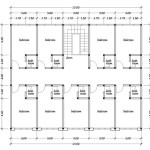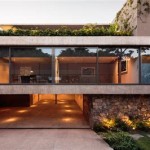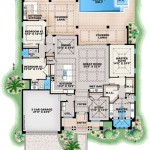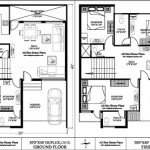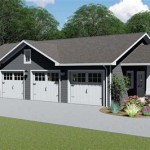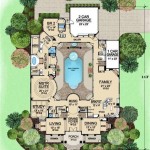Home Plans With Guest Cottage: Expanding Living Options
The integration of a guest cottage into the overall home plan represents a significant architectural and lifestyle choice. These designs offer a multitude of benefits, from accommodating extended family and visiting friends to providing rental income opportunities. Thoughtful planning and design are crucial to ensuring that the guest cottage complements the main house aesthetically and functionally while maintaining privacy and independence for both occupants.
Designing a home with a guest cottage involves considering various factors, including local zoning regulations, building codes, and architectural styles. The specific needs and preferences of the occupants of both the main house and the guest cottage must be taken into account. The placement of the cottage on the property, its size, layout, and amenities, are all critical elements that contribute to the success of the overall design. These plans range from simple, functional spaces to elaborate, fully-equipped residences, each offering a unique solution to the challenges of shared property living.
Key Considerations for Designing Home Plans with Guest Cottages
Several key considerations are paramount when designing a home plan incorporating a guest cottage. These include zoning and legal compliance, privacy and accessibility, and the overall aesthetic integration of the two structures. Careful attention to each of these factors will ensure a harmonious and functional living environment for all occupants.
Zoning and Legal Compliance
Before embarking on the design process, it is imperative to thoroughly investigate local zoning regulations and building codes. Many municipalities have specific rules governing accessory dwelling units (ADUs), which often include guest cottages. These regulations may dictate the maximum size of the cottage, its location on the property, setback requirements, parking provisions, and even restrictions on rental occupancy. Failure to comply with these regulations can result in costly fines or even the need to dismantle the structure.
Zoning regulations often specify the allowable square footage of the guest cottage as a percentage of the main house's square footage. Setback requirements dictate the minimum distance the cottage must be from property lines and other structures. Parking requirements may necessitate the provision of additional parking spaces for the cottage's occupants. Furthermore, some municipalities may restrict the rental of guest cottages to specific time periods or prohibit it altogether. It is advisable to consult with a local planning official or attorney to ensure full compliance with all applicable regulations before proceeding with the design and construction process.
Additionally, building codes will dictate the structural requirements, electrical wiring, plumbing, and safety features of the guest cottage. These codes are designed to ensure the safety and well-being of the occupants and must be strictly adhered to during the construction process. Obtaining the necessary permits and inspections is essential to ensure that the cottage meets all applicable building code requirements.
Privacy and Accessibility
One of the primary goals in designing a home plan with a guest cottage is to maintain privacy for both the main house and the cottage. Thoughtful placement of the cottage on the property is crucial to achieving this goal. Consider factors such as sightlines, noise levels, and access points when determining the optimal location for the cottage.
Strategically positioned landscaping, such as hedges, trees, and fences, can create visual barriers between the two structures, enhancing privacy and creating a sense of separation. Orienting the cottage so that its windows and outdoor living spaces face away from the main house can also help to minimize visual intrusion. The placement of entrances and walkways should be carefully considered to ensure that each unit has its own distinct access point, minimizing the need for occupants to cross paths.
Accessibility is another important consideration, particularly if the guest cottage is intended for use by elderly or disabled individuals. Features such as ramps, wider doorways, grab bars, and accessible bathrooms can make the cottage more comfortable and convenient for occupants with mobility limitations. Universal design principles should be incorporated into the design to ensure that the cottage is accessible to people of all ages and abilities.
Aesthetic Integration
The guest cottage should be aesthetically integrated with the main house and the surrounding landscape. While it is not necessary for the cottage to be an exact replica of the main house, it is important to maintain a consistent architectural style and overall design aesthetic. Using similar materials, colors, and architectural details can help to create a cohesive and harmonious look.
Consider the existing architectural style of the main house when designing the guest cottage. If the main house is a traditional Victorian, the cottage should reflect similar architectural elements, such as gabled roofs, decorative trim, and detailed windows. If the main house is a modern, minimalist design, the cottage should similarly incorporate clean lines, simple forms, and a focus on functionality.
The landscaping surrounding the guest cottage should also be carefully considered to ensure that it complements the overall design aesthetic. Planting trees, shrubs, and flowers that are consistent with the existing landscape can help to blend the cottage seamlessly into its surroundings. Creating a cohesive outdoor living space, such as a patio or garden, can further enhance the overall aesthetic appeal of the property.
Design Elements of a Functional Guest Cottage
The functionality of a guest cottage hinges on its design elements, which must cater to the needs of both short-term and long-term occupants. A well-designed guest cottage incorporates features that promote comfort, convenience, and independence. Key aspects include space optimization, self-sufficiency, and adaptability.
Space Optimization
Guest cottages are often smaller than the main house, making space optimization a critical consideration. Effective space planning can maximize the functionality of the cottage without sacrificing comfort. Multi-functional furniture, such as sofa beds, fold-down tables, and built-in storage, can help to save space and create a more versatile living environment.
Open floor plans can create a sense of spaciousness, even in smaller cottages. Combining the living, dining, and kitchen areas into a single open space can make the cottage feel larger and more inviting. Utilizing vertical space is another effective way to maximize functionality. Tall ceilings can create a sense of grandeur, while lofts can provide additional sleeping or storage space.
Thoughtful storage solutions are essential for keeping the guest cottage organized and clutter-free. Built-in cabinets, shelves, and drawers can provide ample storage space without taking up valuable floor space. Consider incorporating storage into unexpected places, such as under the bed or in the attic. Maximizing natural light can also make the cottage feel more spacious and inviting. Large windows and skylights can bring in plenty of natural light, reducing the need for artificial lighting and creating a more cheerful atmosphere.
Self-Sufficiency
A well-designed guest cottage should be self-sufficient, meaning that it has all the necessary amenities for independent living. This typically includes a fully equipped kitchen, a private bathroom, and a comfortable living area. Providing these amenities allows guests to enjoy their own space without relying on the main house for basic necessities.
The kitchen should include essential appliances such as a refrigerator, stove, microwave, and dishwasher. Ample counter space and storage should be provided for food preparation and storage. The bathroom should include a shower or bathtub, a toilet, and a sink. Adequate ventilation is essential to prevent moisture buildup and maintain a comfortable environment.
The living area should be furnished with comfortable seating, a television, and a table for dining or working. Providing Wi-Fi access is also important, as it allows guests to stay connected and entertained. Consider including a laundry area with a washer and dryer, especially if the guest cottage is intended for long-term occupancy.
Adaptability
A guest cottage should be adaptable to different needs and uses over time. Consider designing the cottage so that it can be easily converted into a home office, a studio, or a rental unit. This flexibility can increase the long-term value of the property and provide options for future use.
Designing the cottage with a neutral color palette and adaptable furniture can make it easier to redecorate and re-purpose the space. Installing flexible lighting systems, such as recessed lighting and track lighting, can allow for different lighting configurations to suit different activities. Consider including a separate entrance to the cottage, which can be useful if the cottage is used as a rental unit or a home office.
Designing the cottage with energy efficiency in mind can also enhance its adaptability and long-term value. Installing energy-efficient windows, insulation, and appliances can reduce utility bills and make the cottage more comfortable to live in. Consider incorporating sustainable design features, such as solar panels or rainwater harvesting systems, to further enhance the cottage's environmental performance.
Benefits of Incorporating a Guest Cottage into a Home Plan
The advantages of including a guest cottage in a home plan are multifaceted, offering both practical and financial benefits. From providing accommodation for extended family to generating rental income, a guest cottage can significantly enhance the value and versatility of a property. These include accommodating family and friends, generating rental income, and increasing property value.
Accommodating Family and Friends
One of the primary benefits of having a guest cottage is the ability to comfortably accommodate visiting family and friends. Providing a private and self-contained space allows guests to enjoy their own independence and privacy without feeling like they are intruding on the main house. This can be particularly beneficial for elderly parents or adult children who may need temporary or long-term housing.
A guest cottage can also provide a convenient space for hosting holiday gatherings or family reunions. Guests can stay on-site without overcrowding the main house, making it easier to manage large groups. The cottage can also serve as a quiet retreat for guests who need a break from the activities in the main house.
For families with adult children, a guest cottage can provide a transitional living space as they gain independence. The cottage can allow young adults to live independently while still being close to family support. This can be particularly helpful for recent college graduates or young professionals who are just starting out in their careers.
Generating Rental Income
A guest cottage can be a valuable source of rental income. By renting out the cottage on a short-term or long-term basis, homeowners can generate additional income to help offset mortgage payments or other expenses. This can be particularly attractive for homeowners who live in popular tourist destinations or areas with high rental demand.
Short-term rentals, such as through platforms like Airbnb or VRBO, can be a lucrative way to generate income from a guest cottage. However, it is important to check local zoning regulations and rental restrictions before listing the cottage for short-term rental. Some municipalities may have specific rules governing short-term rentals, such as requiring permits or limiting the number of days the cottage can be rented out per year.
Long-term rentals can provide a more stable and predictable source of income. Renting the cottage to a long-term tenant can provide a steady stream of income and reduce the need for frequent turnovers. However, finding a reliable and responsible tenant is essential to ensure that the cottage is well-maintained and that rent is paid on time.
Increasing Property Value
Incorporating a guest cottage into a home plan can significantly increase the value of the property. A well-designed and well-maintained guest cottage can be a desirable feature for potential homebuyers, making the property more attractive and competitive in the real estate market. The added living space and potential for rental income can also increase the property's overall value.
When appraising a property with a guest cottage, appraisers will typically take into account the size, condition, and amenities of the cottage, as well as its potential for rental income. A well-appointed and self-sufficient guest cottage can add significant value to the property, especially if it is located in a desirable neighborhood or area with high rental demand.
In addition to increasing property value, a guest cottage can also make the property more versatile and adaptable to changing needs. As families grow and lifestyles evolve, the guest cottage can provide additional living space for aging parents, adult children, or other family members. This flexibility can make the property more appealing to a wider range of potential homebuyers.

Unique Home Plan With Guest Cottage 72681da Architectural Designs House Plans
Small Guest House Plan Floor

Guesthouse Plans For A Small 2 Bedroom Lakeside Cabin

House Plans With In Law Suite Floor Designs

Arts And Crafts Country Home With 5 Bedrms 2473 Sq Ft Plan 108 1692

House Plans With In Law Suites Houseplans Blog Com

Casita Is The Perfect Home Office Guest Quarters Or Mother In Law Suite

Luxury With Separate Guest House 17526lv Architectural Designs Plans

Cozy Cottage Retreat Guest House Getaway Plan

Designing Overnight Guest Space In Your Timber Frame Home

